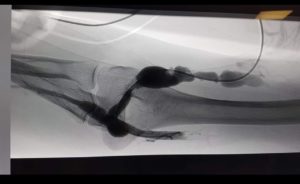What is a fistuloplasty and why do I need one?

Dialysis patient Nikki Fretwell explains the procedure of a fistuloplasty.
If you have an arteriovenous fistula (AVF), there is a possibility that you may need a fistula angioplasty in the future. A fistuloplasty, as it’s commonly known, is a non-surgical procedure to clear a blockage or narrowing (stenosis) in the fistula to improve the blood flow and protect the life of your fistula.
The fistula is our lifeline because it provides our access to haemodialysis. Fistulae do have a lifespan but this varies widely. There are a limited number of veins suitable for a fistula. I’m currently on my third fistula which is over twenty years old.
It has served me well but I do have problems now with stenosis caused by calcium build-up. It is likely that I have no other access should I lose this fistula.
How do I know if I need a fistuloplasty?
If it is difficult to get a good flow on your dialysis, or your needle pressures are unusually high, or your blood results aren’t as good as they should be, then it is possible a fistuloplasty will be needed.
A Transonic machine, which is non-invasive ultrasound, may be used to get a more accurate reading of your venous and arterial flow rates. It will determine the cause of poor flow rates and identify any blockages or narrowing of the fistula; a fistuloplasty is required to remedy these problems. If left untreated, your fistula may stop working altogether and may be irreparable.
What happens during the procedure?
Your fistuloplasty will take place in theatre, usually as a Day-Case admission. It is carried out under local anaesthetic and usually takes about an hour. The procedure will be performed by an interventional radiologist (x-ray doctor). A nurse will be on hand to assist and keep an eye on you. Your blood pressure will be frequently monitored.
Your arm will be cleaned and an injection of Lignocaine is given to numb the area. Yes, it stings! It does only last a few seconds and afterwards, you will mostly experience unusual tugging sensations in your arm.
A catheter is threaded down the fistula and contrast dye is injected. Xrays are taken to show the anatomy of the fistula and pinpoint the problem area/s. The doctor then passes a balloon along the fistula and gently inflates it to widen the narrow part of the vein.
This can be a bit painful so you may be offered gas and air, which helps you to relax and feel less pain. Dye will be injected again to check the success of the widening. Like me, you may be able to watch the live action on a large screen!
Once the fistuloplasty is complete, a small stitch may be put in where the catheter was. You will stay in the waiting area for an hour or so to ensure there is no bleeding. The stitch will be removed by a nurse and you are free to leave!
Are there any risks?
As with any invasive procedure, there are risks. Bruising, bleeding and infection are the most likely. You should not drive immediately after a fistuloplasty. Always look for swelling around the fistula, and if you begin to feel unwell, contact your renal unit urgently.
The success rate is reasonable (80% initially, but 50% at one year; Lau, 2019). For this reason, if you have had a fistuloplasty in the past, there is the likelihood you will need another.
It is not the most enjoyable of experiences but it is a vital one to keep your fistula in the best condition.
Summary
I have described what is a fistuloplasty and why I needed one. I hope it has helped you.
Other resource
These are fistuloplasty patient information leaflets from Glasgow and Coventry.
What is a fistula for dialysis?
Written by Nikki Fretwell.
Last Reviewed on 14 May 2024
